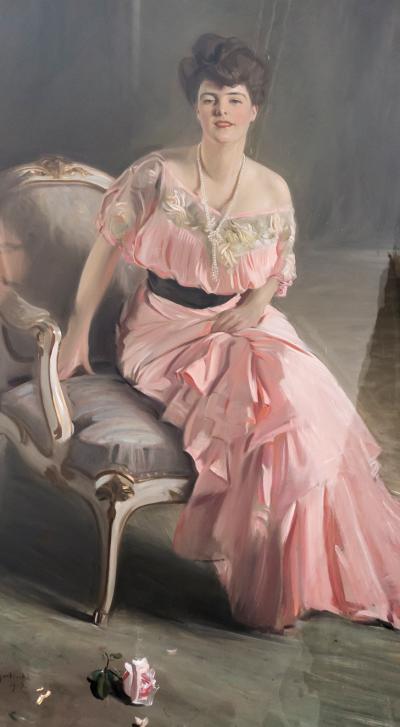Szańkowski, Bolesław

Szańkowski, Bolesław (Boleslaw, Boleslav von Szankowski), Polish portrait and society painter, member of the "Munich School". From 1894-96, he studied at the Academy of Fine Arts, Munich. From 1906-14, he lived and worked as an artist in Munich. In the 1930s, he purchased a house in Fischbachau in the district of Miesbach in Bavaria, where he then lived. *23 October 1873 in Pogwizdów near Miechów (Congress Poland)/Pogwizdów (powiat miechowski), † in Tegernsee, buried 13 March 1953 in Fischbachau. Son of the landowner of the Kępie estate near Miechów/Kępie (województwo małopolskie), Henryk Franciszek Szańkowski h. Krzywda (ca. 1843-1911) and wife Teodora Wężyk (1847-1934). After attending Russian schools, he studied painting at the Academy of Fine Arts/Akademia Sztuk Pięknych in Kraków from 1891 under Florian Cynk (1838-1912), Izydor Jabłoński (1835-1905, both members of the "Munich School"), Władysław Łuszczkiewicz (1828-1900), Jan Matejko (1838-1983) and Józef Unierzyski (1863-1948). On 30 October 1894, he joined the sculpture class of John Caspar Herterich (1843-1905) at the Royal Academy of Fine Arts in Munich. From 1896, he studied at the Académie Colarossi and at the Académie Julian in Paris under the historical painter Jean-Paul Laurens (1838-1921), the orientalist Jean-Joseph Benjamin-Constant (1845-1902) and the portrait painter Antonio de la Gandara (1861-1917). From 1897, he exhibited at the Society for the Promotion of Fine Arts/Towarzystwo Zachęty Sztuk Pięknych in Warsaw (religious subjects and paintings), and from 1899 in Paris at the Salon des Indépendants. In 1900, he travelled to Bombay/Mumbai. In France and England, he achieved great recognition thanks to his portraits of prominent high-ranking personalities. From 1906, he lived in Munich working as a portrait artist and society painter. It is likely that he had a love affair and possibly had a son with the feminist Hélène Escher-von Stürler (1873-1908, see cover image), who hailed from Berne and was part of the Bohemian community in Munich. She took her own life in 1908. In 1907, 1909, 1911 and 1916 portraits of ladies painted by him with the symbolic titles ("Dream", "Vanity") appeared on the cover pages of the Munich art and literature magazine Jugend, and in 1910/11, society scenes, for which the editorial team thought up humorous conversations, were published in the satirical magazine Simplicissimus. In 1907-25, he took part in the exhibitions in the Glaspalast in Munich. For a short time, he was also part of the group surrounding the horse and battle painter Józef Brandt (1841-1915), who was at the heart of the Polish artist scene in Munich and who Szańkowski portrayed in 1910 (National Museum, Warsaw/Muzeum Narodowe w Warszawie). Portrait commissions took him to the court of the tsar in St. Petersburg, to the court of the king in Rumania, to Emperor William II in Berlin and to the nobility and aristocrats in Brussels, Vienna, Lithuania and Poland. During the First World War he lived in Greater Poland, and after the end of the war he lived with the Radziwiłł family. During the 1920s, he travelled to Great Britain, through France and to the US, and exhibited in Geneva and several times in Poland, which he visited regularly. In the 1930s, he purchased a house in Fischbachau in Bavaria, where he then lived. In his early work up to the turn of the century in Kraków, Munich and Paris, Szańkowski still painted the strong, sombre colours common to the Realism style of the late 19th century. These included genre motifs ("Courtship/Zaloty", 1893, National Museum, Poznań), portraits of various social classes, and religious subjects ("Anachoreta/Einsiedler", 1894/98, National Museum, Warsaw). This conservative colourfulness continued during his second stay in Munich (portrait of Józef Brandt, 1910). He even produced quite a masterful copy or adaptation of a genre motif by Brandt, "Market in Balta" (in the DESA auction house, 2015). However, it seems that in Munich Szańkowski no longer moved in the circles of the Polish genre, battle and horse painters surrounding Brandt. Instead, he became known for his portraits of ladies in strikingly elegant contemporary costumes and with exalted, sometimes lascivious poses (from 1909 in the magazine Jugend). His society scenes (from 1910 in the magazine Simplicissimus) show finely dressed ladies and gentlemen in grand houses having animated conversations, with some poses and gestures taking on caricature-like traits. From this point onwards, his portraits of noblemen and society ladies, which were created as oil paintings or pastel drawings and found in private collections throughout Europe, have a light, clay-like colouring (see cover image). From the 1910s, the genres of his portraits of ladies varied from provocative nude pictures to motherly scenes of ladies with their daughters, society ladies in sophisticated dressing rooms in front of a scenic background, right up to full-length portraits in Italian national costumes. His portraits of children, including images of his daughter, show them with flowers, looking pensively ambitious and as genii ("Butterfly – Portrait of his daughter/Motylek – Portret córki artysty", ca. 1917, in the Agra Art auction house, 2007). In his later work from the 1930s, his outline drawings became harder, the colours more rich in contrast, the poses stiffer. The provocative or lascivious gestures seem to increase. His works can be found in the National Museums of Warsaw, Kraków and Poznań, in the Castle Museum, Pszczyna/Muzeum Zamkowe w Pszczynie, in the Neue Pinakothek in Munich, in the art collection at Wahn Castle in Köln-Wahn and in the Jegenstorf Castle Foundation, Canton of Berne, Switzerland.



